The manufacturing industry is in a long, exciting process of data-driven transformation, where advanced analytics plays a deciding role in achieving greater efficiencies, cost reduction, and overall level of innovation. According to a study by Deloitte, predictive maintenance alone can reduce breakdowns rate by 70% and save organizations up to 25% of maintenance costs on average. This is only one use case of data analytics in manufacturing we will be discussing in this article, diving deep into production optimization, supply chain management, informed product development, and more.
The Transformative Impact of Big Data Analytics in Manufacturing
Using Big Data for advanced analytics became a true paradigm shift for the manufacturing industry, paving the way for gaining game-changing insights that previously seemed unattainable. The market size of Big Data analytics in manufacturing sector is estimated at USD 9.07 billion in 2024 and is expected to reach USD 19.25 billion by 2029 if Manufacturing Tomorrow is to be believed. Let’s break down the biggest reasons behind this massive growth.
Benefits of Manufacturing Data Analytics
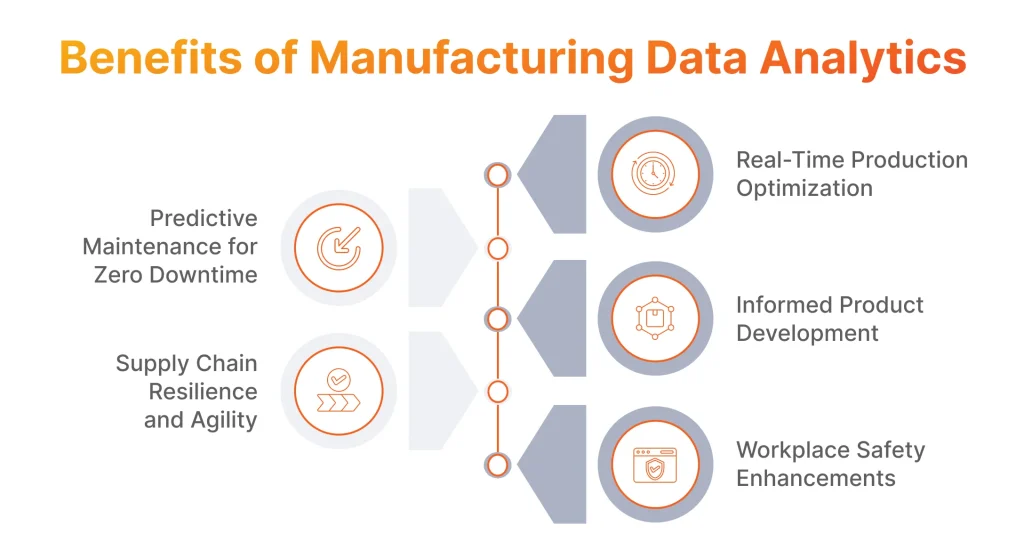
- Real-Time Production Optimization: while traditional manufacturing analytics are built on historical data and manual evaluations, Big Data introduced automated optimization of production workflows and condition monitoring, no matter the scale of operations.
- Predictive Maintenance for Zero Downtime: similar to using data analytics in the Construction industry, predictive maintenance powered by Big Data, IoT, and machine learning can predict machinery failures for manufacturers before they even happen, unlike reactive maintenance with fixed intervals done previously.
- Supply Chain Resilience and Agility: advancements in Big Data and Artificial Intelligence for supply chain optimization allow manufacturers to get holistic visibility across their supply chains and make proactive adjustments according to disruptions and changes in demand.
- Informed Product Development Through Market and Operational Insights: Big Data helps to develop new products faster and more precisely, by analyzing customer preferences and production insights, massively reducing the risk of failure for a new product.
- Workplace Safety Enhancements Through Predictive Analysis: unfortunately, previously rules and safety measures in manufacturing were set as a response to severe incidents. Now, analytics can help monitor equipment performance and hazardous conditions to prevent risks long before they turn into tragedies.
Dmytro Tymofiiev
Delivery Manager at SPD Technology
“Here, at SPD Technology, we recognize Big Data analytics as the main transformative force for manufacturers and know how to leverage this technology to achieve tangible business value for organizations of all sizes. The key here is to provide a holistic approach to implementation, using collected data to cover all possible areas that can benefit from it.”
Key Applications of Manufacturing Analytics
Let’s review some of the most prominent manufacturing analytics use cases that are making an impact in the industry right now.
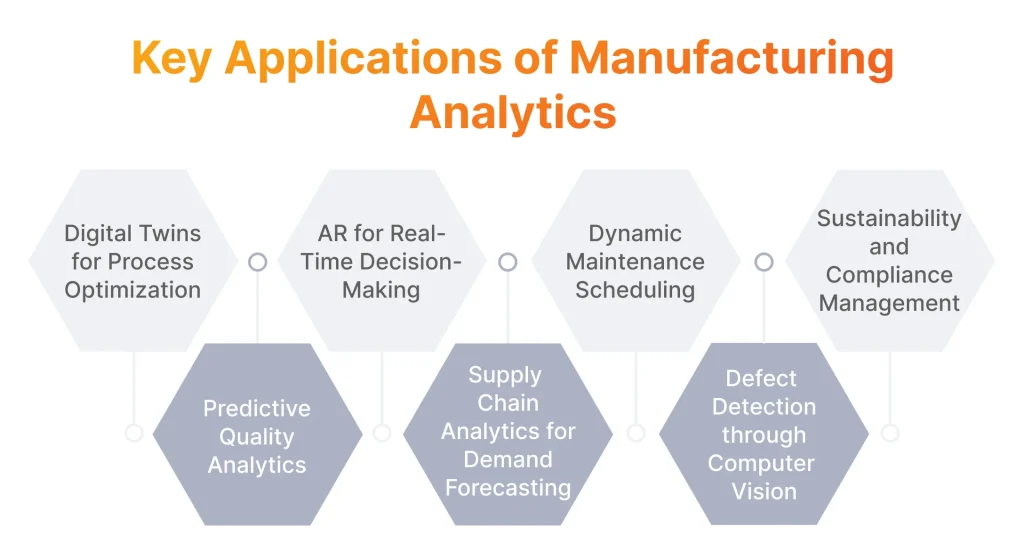
Digital Twin Technology for Process Optimization
To put it simply, the digital twins technology makes it possible for manufacturers to build virtual copies of their most important assets, key processes, and production facilities, which allows testing and refining operational changes without any interruption to the production processes. Top off-the-shelf solutions on the market include:
- Siemens Xcelerator
- AVEVA Digital Twin
- Dassault Systèmes 3DEXPERIENCE Platform.
Predictive Quality Analytics
This one changes manufacturing business analytics by shifting the focus from a reactive approach to dealing with production issues into proactive quality assurance practices. It became possible thanks to the advancements in machine learning development and IoT. Predictive quality analytics is now one of the most used applications, with the top solutions including:
- ETQ Reliance Predictive Quality Analytics
- Vanti AI’s Predictive Analytics Platform
- Seebo Predictive Quality Solutions.
Augmented Reality (AR) for Real-Time Decision-Making
Overlaying analytics onto processes or equipment, AR has become one of the most interesting ways of implementing production monitoring in the industry. In the context of a smart factory, it is possible to build an app for smart glasses that will display the metrics of equipment health in real time, allowing technicians to make quick adjustments when necessary. The most prominent solutions in this category include:
- Siemens AR Solutions
- Dassault Systèmes’ 3DEXPERIENCE Platform
- Autodesk AR Tools.
Inventory and Supply Chain Analytics for Demand Forecasting
Supply chain manufacturing can benefit from predictive analytics by synchronizing inventory schedules with changes in demand, powering up an entire supply chain, and significantly reducing waste and operational inefficiencies related to the lack of data. Among the top solutions we should mention are:
- Oracle Demand Management
- Blue Yonder
- Streamline.
Dynamic Maintenance Scheduling
As an alternative to traditional methods with fixed schedules, IoT-driven analytics leverage data-based insights to deliver outstanding maintenance process optimization, alerting on cases where the involvement of the technicians is truly required. The solutions that have already made waves with this include:
- Deloitte’s Manufacturing Execution System
- GE Digital’s Asset Performance Management
- Siemens Opcenter Advanced Planning and Scheduling.
Defect Detection Through Computer Vision and AI
Computer vision development already evolved into something that changed the quality control approach for modern manufacturers. Visual data analysis, computer vision, and AI solutions have already proven to be much more effective, compared to manual inspections, just like our AI/ML-powered Defect Prevention System for Equipment Inspection project showed.
In this project, we delivered a full-scale AI-driven platform capable of predicting, detecting, and managing equipment/asset defects. During the development process, we implemented a set of technologies including NLP, object recognition, anomaly detection, video and image analysis, and sensor data analysis. In addition to defect detection functionality, we also developed digital twins, an AI chatbot, and automated reporting features.
As for off-the-shelf solutions, you should pay attention to:
- Google Cloud Visual Inspection AI
- Landing AI’s Computer Vision Platform
- Altair’s Visual Inspection AI
Sustainability Tracking and Compliance Management
Modern manufacturing process analytics can help with this area as well, by tracking waste production, energy use, and the level of emissions, ensuring regulatory compliance by making targeted adjustments in the core processes. The most interesting solutions in this category are:
- Normative
- Enhesa
- Nasdaq Metrio.
The Future Trends of Data Analytics for Manufacturing
Manufacturers use analytics to foster innovation and drive operational efficiency beyond the limits. Here is a quick overview of the technologies that stand out the most.
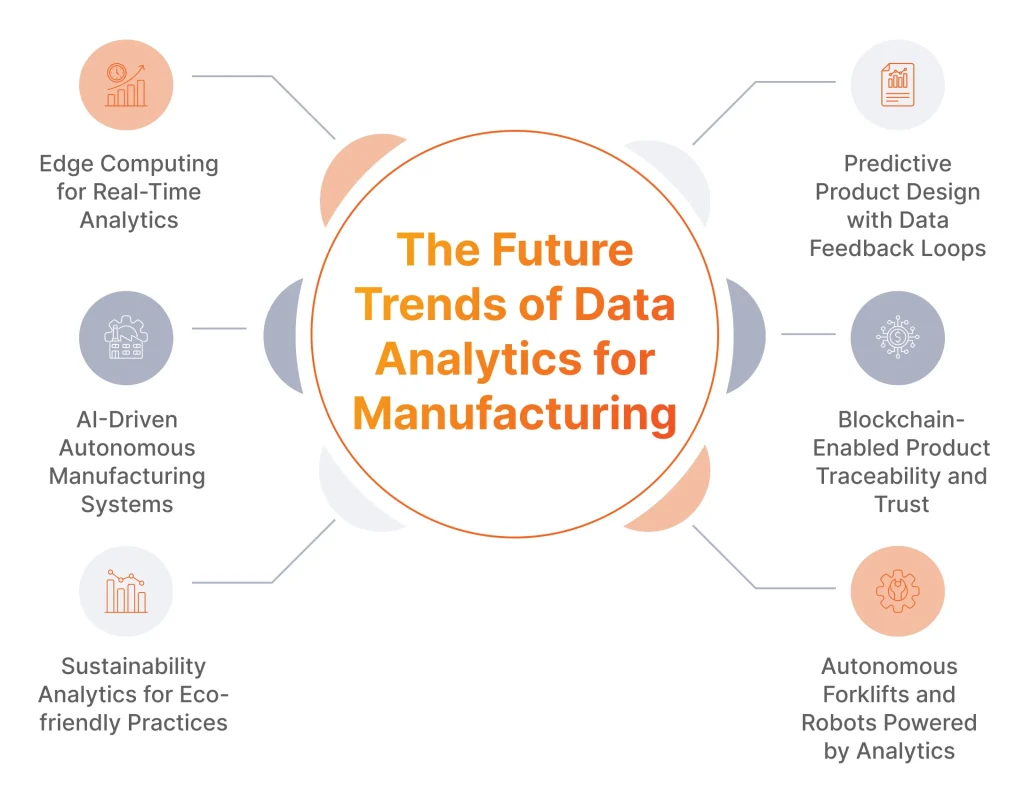
Edge Computing for Real-Time Analytics
This technology allows for data processing nearly, or directly at equipment, eliminating the latency challenge that cloud systems have. With the global edge computing market reaching USD 18.36 billion by 2027, according to forecasts by Fior Markets, the growth is predictable, since this technology allows increasing the adoption of smart machinery for organizations.
AI-Driven Autonomous Manufacturing Systems
Being a great example of robotic process automation development, Artificial Intelligence helps manufacturers to automate and optimize their production processes without much of a human intervention. Siemens already reported a 90% cost reduction on assembly lines thanks to AI-enabled robots.
Sustainability Analytics to Drive Eco-Friendly Practices
Data analytics initiatives help manufacturers to cover multiple areas, from energy consumption monitoring to supply chain optimization for minimal carbon footprints, helping to achieve eco-friendly goals and meet the regulations. We already discussed how Artificial Intelligence transforms power management, so we welcome you to read about more specific use cases and statistics.
Predictive Product Design with Data Feedback Loops
Similar to other industries like Retail and eCommerce, manufacturers are also starting to leverage operational and customer data to directly influence the designs of future products. With the usage of data feedback loops, it is possible to leverage customer data during the development process, securing the success of an end product.
Blockchain-Enabled Product Traceability and Trust
The blockchain in the manufacturing market is projected to reach USD 252.53 by the end of 2024, according to Presswire. This technology serves manufacturing as a way to improve transparency across the entire supply chain, helping to trace raw materials, monitor production, and offer customers detailed product histories.
Autonomous Forklifts and Robots Powered by Analytics
Another great example of RPA in Manufacturing is the robots with insights into production analytics that can take over logistics, inventory management, and mundane tasks, lowering the risk of human error and freeing up the hands of human experts. Similar to the ways RPA and Artificial Intelligence improves logistics, robots in manufacturing can save up to 30% of production costs if the Robot Report is to be believed.
Dmytro Tymofiiev
Delivery Manager at SPD Technology
“I believe that we are already at the point where operation and business analytics in the manufacturing industry is no longer optional, but rather a vital component for any organization that wants to stay competitive. The future belongs to those who will find ways to harness analytics to drive a transformative change.”
Best Practices for Manufacturing Data Analysis Implementation
To truly benefit from the advanced business intelligence and analytics software, it is vital to implement it properly. This section will share our practical insights on ensuring that the solution will be implemented most effectively.
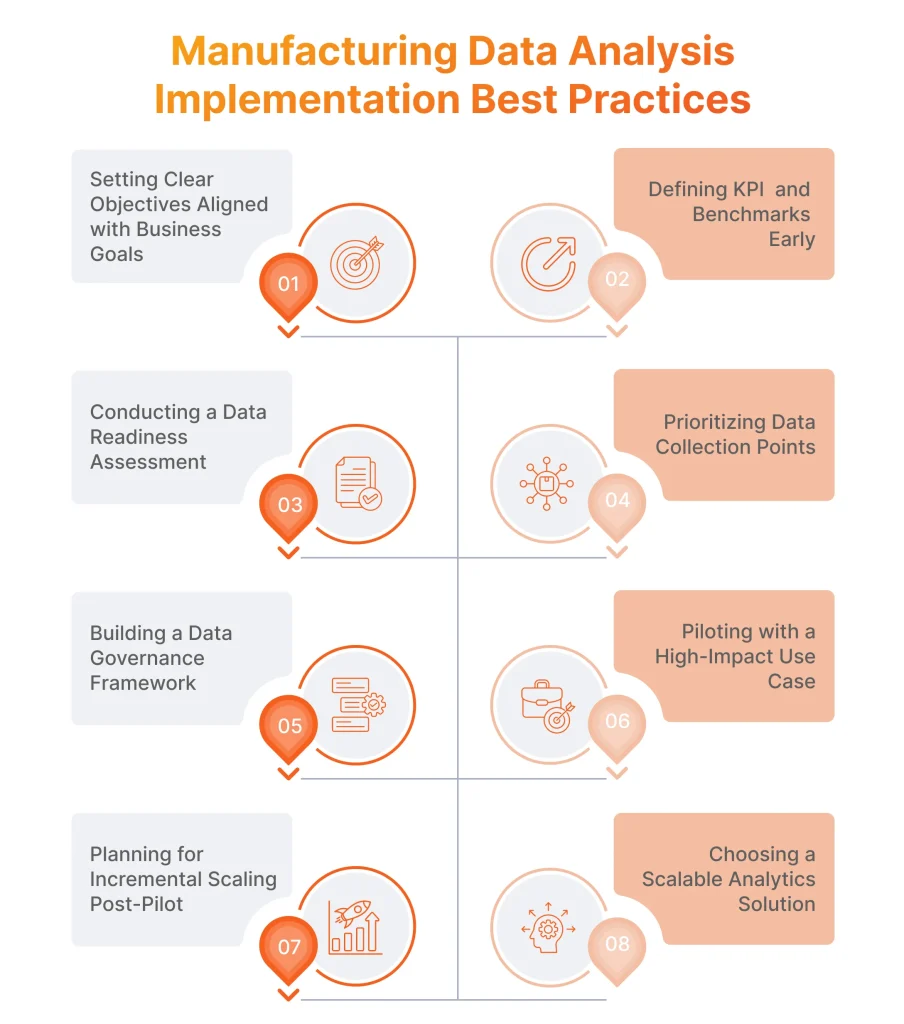
Starting with Clear Objectives Aligned with Business Goals
It all begins with defining how manufacturing data analysis tools can support specific business goals of your organization, as well as critical processes like inventory management, overall production quality, and efficiency. All your analytics in the manufacturing initiatives should be purpose-driven from the very start, focusing on tangible goals and pain points.
Defining Key Performance Indicators (KPIs) and Setting Benchmarks Early
Next, after the areas to cover, comes defining KPIs for the analytics initiatives, and specific data points that may include machine utilization or yield rates. The initial benchmarks need to be set to determine the starting points and to monitor specific goals to achieve. By having clear KPIs, you will be able to easily understand whether the manufacturing operations analytics solution is paying off.
Conducting a Data Readiness Assessment
To ensure that the information your organization has is meeting the demands of effective manufacturing industry data analysis, it will be a wise move to assess the current state of data sources. During this evaluation, any possible data gaps should be identified, as well as data quality issues and the limitations of the infrastructure. At this stage, it is necessary to determine what you may be missing and have the time to fix this.
Assessing the organization’s data readiness is also one of the first steps towards developing an effective enterprise data strategy.
Discover expert opinions about this task in our featured article!
Prioritizing Data Collection Points in Production and Quality Control
It makes sense to prioritize collecting data from the areas that matter the most, and have the biggest influence on the overall performance of the organization. These areas most commonly include quality control stations, maintenance logs, and production lines. The targeted data collection results in a strong foundation for manufacturing data and analytics, improving KPIs for operational efficiency.
Building a Data Governance Framework
If you are familiar with the advantages of strategic technology consulting or have worked with any data-related project in a large organization, you know that establishing a framework for managing data access, security and integrity is one of the keys to success. Having a structured data governance framework ensures that data is available for advanced analysis across all departments.
Piloting with a High-Impact Use Case
The first manufacturing analytics use cases you are planning to introduce should be impressive and set a positive precedent for future initiatives. Projects like a predictive maintenance solution for critical machinery or quality control automation for production lines should be enough to secure stakeholder buy-in across the organization and get the necessary approvals for the next initiatives more easily.
Planning for Incremental Scaling Post-Pilot
With the pilot project’s success, you should be set for the gradual scaling of your first initiative. It makes sense to expand in incremental phases, which will reduce the operational and financial risks and will allow the development team to keep up with changes in the workflows. By doing this, you will be able to implement data-driven practices without disrupting key processes in the organization.
Choosing a Scalable Analytics Solution that Grows with Your Needs
It will be a good idea to choose scalable data analytics for manufacturing industry because most likely the capacity of your operations will eventually grow over time. With a scalable solution, it is possible to handle significantly bigger data volumes, integrate entirely new data sources and formats, as well as introduce entirely different use cases in the future.
Dmytro Tymofiiev
Delivery Manager at SPD Technology
“I think, to successfully implement any data analytics manufacturing solution, a strong alignment between business and analytics goals is required, keeping stakeholders and software developers on the same page. Based on our experience, I know it is possible, as we already built scalable solutions with strong data governance practices that secure continuous improvement for our clients all over the globe.”
Choosing the Right Manufacturing Analytics Solution – Custom vs Ready-Made
While selecting the approach to introduce modern manufacturing analytics solutions, organizations should go with an off-the-shelf solution or build a tailored one from scratch. Both options have distinctive advantages and disadvantages and benefit different scenarios depending on specific business needs.
Ready-Made Manufacturing Data Analytics Solution
There are plenty of interesting options on the market you can choose from, including Siemens MindSphere, GE Predi, and IBM Maximo. Let’s discuss the pros and cons of using them.
Pros:
- Faster Time to Implementation: designed for the quickest deployment, pre-built solutions allow deploying analytics software right away, without any major preparations and minimal-to-none downtime.
- Lower Initial Costs: while some customization and development are still required, off-the-shelf data analytics manufacturing solutions require lower upfront costs and are much more accessible for organizations without big budgets for manufacturing analytics software.
- Proven Reliability and Support: ready-made solutions are supported by global providers that offer round-the-clock support with regular updates, which minimizes risks of downtime for manufacturers.
Cons:
- Limited Customization: ready-available software is typically designed for general needs, and may lack specific features that you require to seamlessly fit your unique operational workflows.
- Integration Challenges with Existing Systems: There can also be problems with integrating Manufacturing analytics software with legacy systems and existing tools, leading to data silos and the need for additional solutions.
- Scalability Issues: as your business evolves, the ready-made solution of your choice may lack scalability or the power to process the increased need for sophisticated manufacturing analytics.
Custom Manufacturing Data Analytics Solution
On the other side of the spectrum is a tailored approach, in which data analytics services will be delivered in the form of a custom solution.
Pros:
- Tailored to Specific Business Needs: custom solutions are built from the ground up to cater to specific business needs, processes, production lines, and operational requirements, bringing close alignment with the strategic goals.
- Seamless Integration with Existing Systems: being designed with a particular company in mind, the solution will be integrated with the ERP, MES, or other systems, and will be able to deliver holistic production data analysis.
- Long-Term Scalability and Flexibility: with a custom software developer, you will be able to design a Manufacturing analytics solution with the growth of your organization in mind, so the software will accommodate your evolving needs.
Cons:
- Higher Initial Costs: you should be ready for a significant upfront investment that includes substantial costs for design, development, and complete integration with ongoing support.
- Longer Time to Deployment: the development cycle for a custom data analytics manufacturing solution is quite extensive, with long plan and design phases, adding up to a long time before deployment.
- Requires Expertise for Ongoing Maintenance and Support: finally, you will need dedicated resources for the maintenance of the custom system, as the demand for production data analysts and system architecture grows.
Dmytro Tymofiiev
Delivery Manager at SPD Technology
“While requiring a higher upfront investment compared to off-the-shelf software, a custom approach will result in a long-lasting, powerful tool for manufacturing data analytics that from the very start will fit the needs of your business like a glove. In the long run, advantages in flexibility, scalability, and integration make custom development a more wise and strategic choice for long-term projects.”
Challenges of Implementing Advanced Manufacturing Analytics
Implementing modern analytics in the manufacturing industry brings unique challenges, including working with dated infrastructures, and combining entirely different data sources, while having strict requirements for close-to-real-time insights. We, at SPD Technology, have the knowledge and practical experience to overcome these challenges, and we would like to share our insights with you.
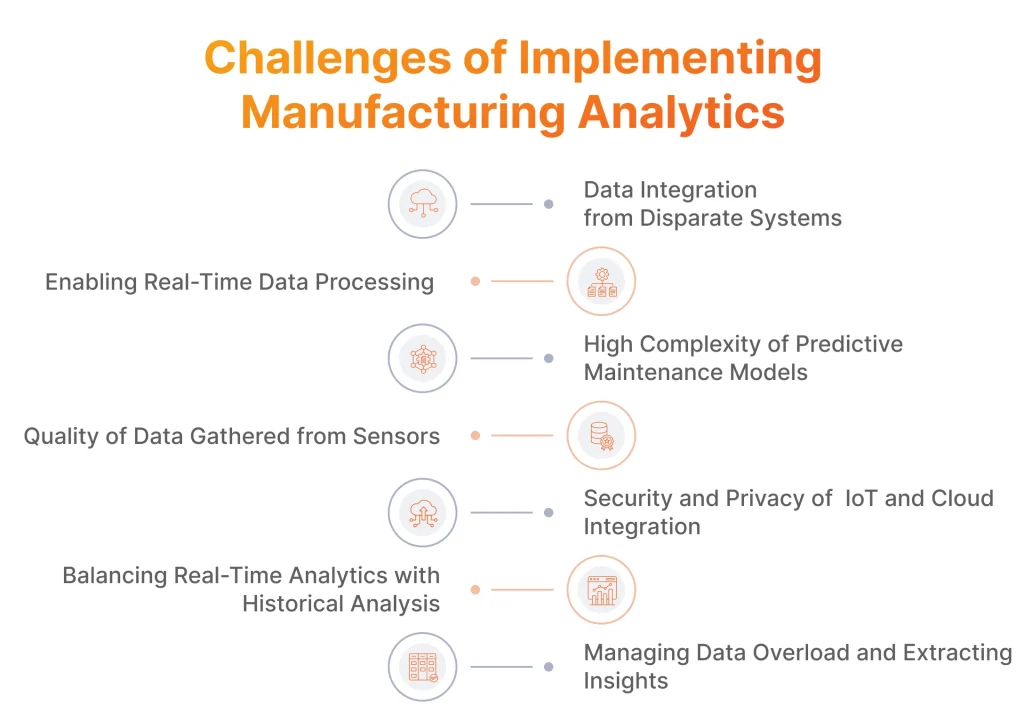
Data Integration from Disparate Systems
It is common for large manufacturing companies to have their data scattered across entirely different departments, including production, quality control, inventory, and maintenance. This makes enterprise data management more complex since each department frequently has its data format.
Having encountered this problem many times before and understanding the importance of data integration, we employ efficient integration frameworks, and through API-based solutions, our team holistically centralizes data for cohesive data streams.
Enabling Real-Time Data Processing
We secure uninterrupted, close-to-instant data processing at scale by deploying platforms like Apache Kafka and Apache Flink, delivering systems that are capable of dealing with massive amounts of traffic with the lowest latency possible. Our experts are capable of achieving real-time manufacturing analytics by leveraging edge computing and pre-processing data close to the source.
High Complexity of Predictive Maintenance Models
Artificial Intelligence and the Internet of Things are both very complex technologies and proficiency in them is required to capitalize on the predictive maintenance process. We, at SPD Technology, have years of proven experience in developing innovative ML models using random forests and neural networks, optimizing them to recognize a variety of factors including the quality of sensor data and different environmental factors.
Quality of Data Gathered from Sensors
The accuracy of sensor data is vital for any manufacturing analytics software. Our engineers secure the accuracy of data by implementing calibration and validation protocols and detecting any anomalies that might occur. It is possible to harness the power of machine learning and even compensate for occasional sensor errors by implementing predictive analytics and keeping the flow of consistent insights even through the toughest conditions.
Security and Privacy of IoT and Cloud Integration
While numerous cloud computing infrastructure benefits are the reason to use this technology in the first place, there are some major security concerns related to the cloud-based Internet of Things integrations. We are well aware of them, always prioritize data security, and employ rigorous security measures. Our practices include end-to-end encryption, secure authentication, and regular audits. Additionally, we are practitioners of edge computing, minimizing data transferred to the cloud.
Balancing Real-Time Analytics with Historical Analysis
Combining historical and real-time data is very challenging from the technical perspective, but very valuable from the organizational side, resulting in holistic Manufacturing analysis. To achieve this goal, our team of professionals design hybrid models, in which streaming analytics and historical data are integrated via time-series databases, as well as data lakes. These insights are being integrated into a single platform for outstanding operational visibility.
Managing Data Overload and Extracting Insights
Being fully aware of the business impact of Big Data, we understand the importance of managing high data volumes to prevent disruptive instances of overload. For proper manufacturing management analytics, we implement AI-driven filtering approaches, prioritizing the most important data and using data analytics to flag and report any significant events. We also develop customized dashboards for effective data visualization, allowing our clients to see the most relevant insights.
Dmytro Tymofiiev
Delivery Manager at SPD Technology
“To achieve the most beneficial manufacturing analytics, you should do more than just an accurate and timely data collection, but rather conduct a holistic process that includes deep integration across systems, real-time processing capabilities, and a robust approach to data quality and security. We know how to align analytics for manufacturers with unique operational demands and deliver the advantage through tailored insights.”
Leverage Big Data Analytics for Manufacturing with Professional Tech Support
In order to maximize the effectiveness of Manufacturing data analysis initiatives and implement solutions properly, not only specialized expertise is required, but also a practical knowledge of industry-specific challenges. Hiring a professional team could be the most reasonable move to capitalize on your business data.
By joining forces with specialized developers, manufacturers can leverage their proficiency in data engineering and machine learning, required for modern data analytics solutions. With this help, you will receive faster time-to-value from your initiatives, as you will get actionable insights as fast as possible. There is also the challenge of integrating advanced data analysis solutions with existing infrastructures and legacy systems, ensuring seamless data flow – the task that true professionals can handle.
Partner with a Reliable Data Analytics Development Vendor
We, at SPD Technology, have cross-industrial experience with the implementation of sophisticated AI and machine learning solutions and a long list of completed projects fo our global clients from the manufacturing industry.
In all of our data-related solutions, we prioritize the highest measures of security and a tailored approach, closely aligned with the goals and the visions of our clients. As for projects with advanced analytics in manufacturing, we focus on the expansion of capabilities for operational growth thanks to cost-effectiveness and scalability.
We know how to implement the most complex projects, with minimal-to-none disruption to the key operations, seamlessly integrating data analytics for manufacturing with existing systems in a cohesive infrastructure. Our team supports the projects as long as needed, offering continuous improvements and adapting manufacturing data analysis software according to changing industry trends.
SPD Technology’s Experience with Analytic Manufacturing Systems
Among our data analytics use cases in manufacturing are projects that deliver the clients the fullest potential of the technology with outstanding operational agility. Let’s take a closer look at one of the recent.
Developing a Modern ML Solution for a Packaging Manufacturer
Business Challenge
Our client is an American manufacturer of liquid packaging board and market pulp with over 70 years on the market. We were tasked to build an ML-powered tool for paperwork and invoice processing automation, delivering our expertise in Artificial Intelligence for the manufacturing industry.
SPD Technology Approach
For this project, we assembled a team of a Project Manager and a vetted ML Engineer with proficiency in Python. In the initial Proof of Concept, we decide to use Gradient Boosting Classifiers and Text Embeddings Models and proceed with the development.
We built a Python pipeline that classifies item lines in invoices, using AWS Textract to extract text and tabular data from PDFs. We ensured data accuracy and completeness by leveraging text classification and embeddings to make the pipeline accurately categorize item lines.
Labeled invoice data was used to train the model. We curated a balanced, labeled dataset and measured performance with precision, recall, and F1-score metrics to ensure text classification accuracy.
The model was integrated into the client’s custom CRM via API.
Value Delivered
- Massive Improvement of Data Aggregation Speed: we reduced the pace for aggregation of information from weeks to hours.
- Completely Automated Invoice Processing: our ML-powered tool predicts the master service code of an item in an invoice by its textual description without any human intervention.
Ultimately, in a 6 months period, we built an innovative software solution for invoice processing automation that fully supports primary business objectives for our client and significantly reduces manual effort.
Conclusion
The forecasts for data analysis in the manufacturing market are looking to be very optimistic, with the increase from USD 14.26 billion in 2024 to USD 32.39 billion in 2028, as The Business Research Company reports. This growth is based on tangible benefits that data analytics in manufacturing industry brings to the table, including boosted productivity, improved quality, and increased profitability. Data analytics unlock previously untapped opportunities to make more informed decisions and quickly respond to changes in the performance of the equipment, as well as market demands.
We, at SPD Technology, fully understand the transformative power of data analytics and are ready to build a game-changing manufacturing analytics solution for your organization. Consider our data analytics consulting services, and we will help you drive innovation and develop a sustainable path to success in your industry.
FAQ
How is Data Analytics Used in Manufacturing?
Data analytics helps manufacturers in multiple ways, including:
- Predictive Maintenance
- Improved Quality Control
- Supply Chain Optimization
- Enhanced Production Efficiency
- Energy Usage Optimization.
What Are the Benefits of Big Data Analytics in the Manufacturing Industry?
Big Data analytics for manufacturing brings several major advantages to the industry, including eliminating production bottlenecks through data insights, minimizing equipment failures thanks to advanced predictive maintenance processes, saving costs due to energy consumption improvements and supply chain optimization, and increasing flexibility in decisions thanks to data-driven insights.
What Insights Can You Provide with Analytics to the Manufacturing Industry?
Probably, the most notable impact is from insights into performance metrics, in particular, machine efficiency, labor productivity, and production speed. Additionally, demand forecasting plays a big role in predicting customer demand patterns, providing manufacturers with valuable insight into their supply chain meeting market needs.

